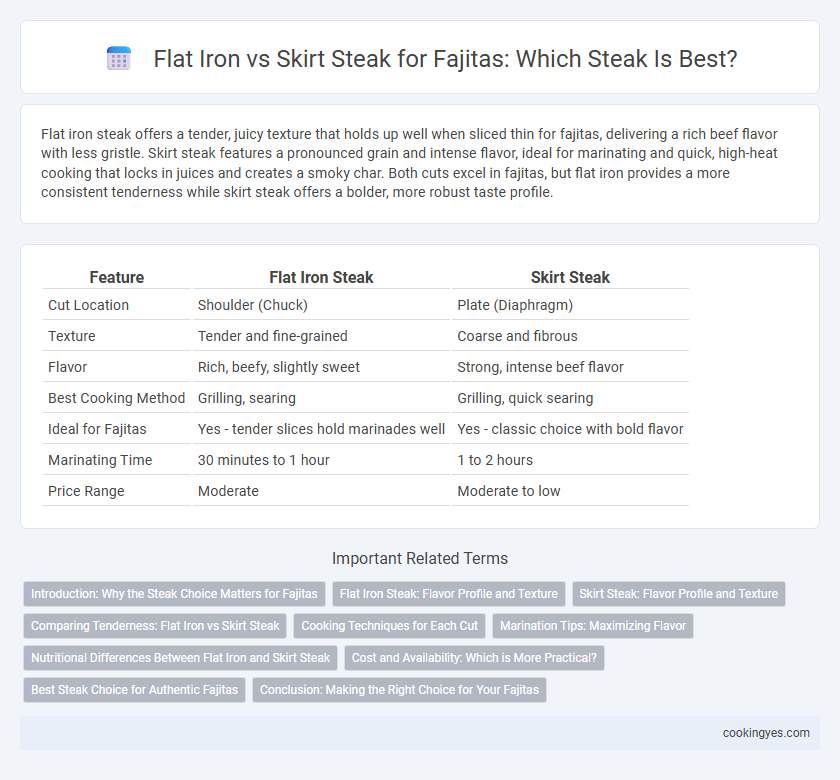Flat iron steak offers a tender, juicy texture that holds up well when sliced thin for fajitas, delivering a rich beef flavor with less gristle. Skirt steak features a pronounced grain and intense flavor, ideal for marinating and quick, high-heat cooking that locks in juices and creates a smoky char. Both cuts excel in fajitas, but flat iron provides a more consistent tenderness while skirt steak offers a bolder, more robust taste profile.
Table of Comparison
| Feature | Flat Iron Steak | Skirt Steak |
|---|---|---|
| Cut Location | Shoulder (Chuck) | Plate (Diaphragm) |
| Texture | Tender and fine-grained | Coarse and fibrous |
| Flavor | Rich, beefy, slightly sweet | Strong, intense beef flavor |
| Best Cooking Method | Grilling, searing | Grilling, quick searing |
| Ideal for Fajitas | Yes - tender slices hold marinades well | Yes - classic choice with bold flavor |
| Marinating Time | 30 minutes to 1 hour | 1 to 2 hours |
| Price Range | Moderate | Moderate to low |
Introduction: Why the Steak Choice Matters for Fajitas
Choosing the right steak for fajitas significantly impacts flavor and texture, with flat iron offering a tender, juicy bite due to its marbling and muscle structure. Skirt steak, known for its rich, beefy taste and pronounced grain, provides a more intense flavor but requires careful slicing against the grain to maximize tenderness. Understanding these differences ensures an optimal fajita experience that balances taste and mouthfeel.
Flat Iron Steak: Flavor Profile and Texture
Flat iron steak offers a rich, beefy flavor with a tender, fine-grained texture that makes it ideal for fajitas, providing a juicy and satisfying bite. Its marbling ensures consistent moisture during cooking, resulting in a succulent and flavorful experience compared to the more fibrous and intense skirt steak. The flat iron's even thickness allows for uniform cooking, enhancing the overall taste and mouthfeel in fajita dishes.
Skirt Steak: Flavor Profile and Texture
Skirt steak offers a rich, beefy flavor with a pronounced, slightly chewy texture, making it ideal for fajitas that benefit from bold taste and tender bite. Its long, fibrous grain allows it to absorb marinades deeply, enhancing the smoky and spicy seasoning typical of fajita recipes. When cooked quickly over high heat, skirt steak delivers a perfect balance of juiciness and robust flavor that stands out in traditional Tex-Mex dishes.
Comparing Tenderness: Flat Iron vs Skirt Steak
Flat iron steak offers a tender, well-marbled texture, making it ideal for fajitas that require a juicy and soft bite. Skirt steak, while flavorful and slightly chewier due to its long muscle fibers, benefits from marinating and quick high-heat cooking to enhance tenderness. Choosing flat iron steak maximizes tenderness, whereas skirt steak delivers a robust texture that holds up well with bold seasoning.
Cooking Techniques for Each Cut
Flat iron steak requires quick, high-heat cooking methods such as grilling or pan-searing to achieve a tender, juicy texture ideal for fajitas. Skirt steak benefits from marinating and cooking over intense heat for a shorter time to enhance its natural beefy flavor and prevent toughness. Both cuts should be sliced thinly against the grain to maximize tenderness and maintain the traditional fajita bite.
Marination Tips: Maximizing Flavor
Flat iron steak and skirt steak both benefit from marination to enhance their natural flavors and tenderize the meat, making them ideal for fajitas. Use a marinade with acidic ingredients like lime juice or vinegar, combined with garlic, cumin, and chili powder to break down muscle fibers and infuse bold, Mexican-inspired flavors. Marinate for at least 2 to 4 hours, avoiding overly long soaking to prevent mushy texture, ensuring a juicy, flavorful result when grilled.
Nutritional Differences Between Flat Iron and Skirt Steak
Flat iron steak offers a higher protein content and lower fat compared to skirt steak, making it a leaner choice for fajitas with approximately 23 grams of protein and 8 grams of fat per 3-ounce serving. Skirt steak contains more fat, around 12 grams per 3-ounce portion, contributing to its rich flavor and tenderness but increasing calorie count. Both cuts provide essential nutrients like iron and zinc, though flat iron steak tends to have slightly fewer calories, supporting a healthier calorie-conscious meal option.
Cost and Availability: Which is More Practical?
Flat iron steak generally offers a more affordable option compared to skirt steak, making it a practical choice for budget-conscious fajita preparations. Widely available in many supermarkets and butcher shops, flat iron tends to be easier to source year-round, whereas skirt steak may have seasonal availability and higher price fluctuations due to its popularity. Consumers prioritizing cost-effectiveness and consistent access often find flat iron steak to be the more convenient option for fajitas.
Best Steak Choice for Authentic Fajitas
Flat iron steak offers a tender, well-marbled texture with a rich beefy flavor, making it an excellent choice for fajitas that require juicy, melt-in-your-mouth meat. Skirt steak, known for its robust flavor and fibrous texture, is traditionally favored in authentic fajitas, providing a slightly chewier bite that absorbs marinades deeply. For authentic fajitas, skirt steak remains the best choice due to its classic taste and ability to retain seasoning, while flat iron steak offers a tender alternative perfect for those preferring a softer texture.
Conclusion: Making the Right Choice for Your Fajitas
Flat iron steak offers a tender texture and rich, beefy flavor ideal for fajitas, while skirt steak delivers a more pronounced, slightly chewier bite with intense marbling that enhances juiciness. Choosing between flat iron and skirt steak depends on your preference for tenderness versus bold, fatty flavors in fajita preparation. Both cuts benefit from marinating and high-heat, quick cooking methods to maximize flavor and preserve juiciness in authentic fajitas.
Flat iron vs Skirt steak for fajitas Infographic

 cookingyes.com
cookingyes.com